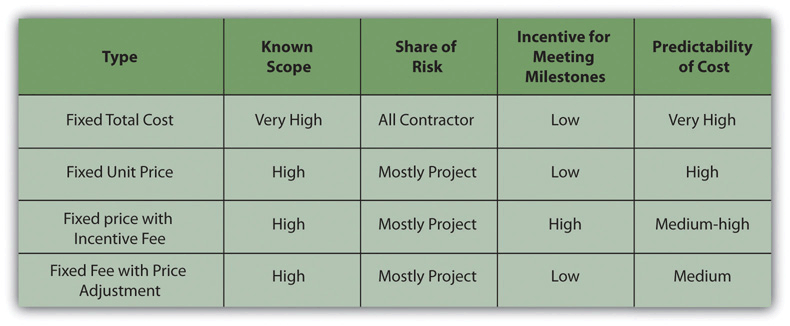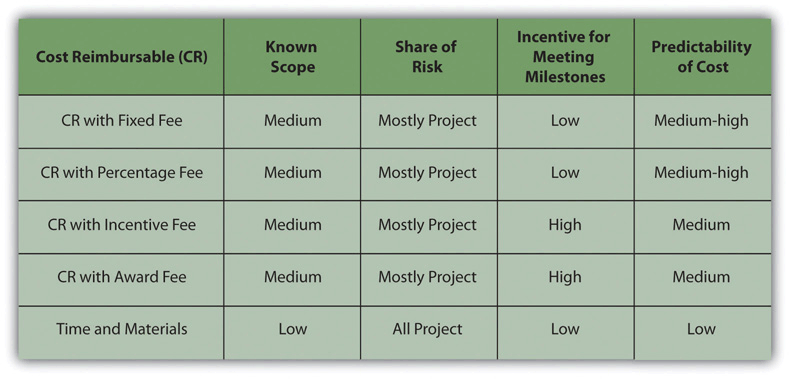9.5 Selecting the Type of Contract
Visit Audio Recordings for the audio version of this section.
LEARNING OBJECTIVES
- Identify factors that determine which type of contract to select.
- Describe the types of fixed cost contracts.
- Describe the types of cost reimbursable contracts.
- Understand progress payments and how to reduce problems in changing the contractors’ scope of work.
An agreement between the organization and an outside provider of a service or materials is a contract. To limit misunderstandings and make them more legally binding, contracts are usually written documents that describe the obligations of both parties and are signed by those with authority to represent the interests of the parties.
Because legal agreements often create risk for the parent organization, procurement activities are often guided by the policies and procedures of the parent organization. After the project management team develops an understanding of what portions of the project work will be outsourced and defines the type of relationships that are needed to support the project execution plan, the procurement team begins to develop the contracting plan. On smaller, less complex projects, the contract development and execution is typically managed through the parent company or by a part-time person assigned to the project. On larger, more complex projects, the procurement team can consist of work teams within the procurement function with special expertise in contracting. The contract plan defines the relationship between the project and the subcontractors (supplier, vendor, or partner) and also defines a process for making changes in the agreement to accommodate changes that will occur on the project. This change management process is similar to the change management process used with the project agreement with the project client.

The contracting plan of the project supports the procurement approach of the project. The following are some factors to consider when selecting the type of contract:
- The uncertainty of the scope of work needed
- The party assuming the risk of unexpected cost increases
- The importance of meeting the scheduled milestone dates
- The need for predictable project costs
There are several types of contracting approaches and each supports different project environments and project approaches. The legal contracts that support the procurement plan consist of two general types of contract: the fixed-price and the cost-reimbursable contracts, with variations on each main type.
Fixed-Price Contracts
The fixed-price contract is a legal agreement between the project organization and an entity (person or company) to provide goods or services to the project at an agreed-on price. The contract usually details the quality of the goods or services, the timing needed to support the project, and the price for delivering goods or services. There are several variations of the fixed price contract. For commodities and goods and services where the scope of work is very clear and not likely to change, the fixed price contract offers a predictable cost. The responsibility for managing the work to meet the needs of the project is focused on the contractor. The project team tracks the quality and schedule progress to assure the contractors will meet the project needs. The risks associated with fixed price contracts are the costs associated with project change. If a change occurs on the project that requires a change order from the contractor, the price of the change is typically very high. Even when the price for changes is included in the original contract, changes on a fixed-price contract will create higher total project costs than other forms of contracts because the majority of the cost risk is transferred to the contractor, and most contractors will add a contingency to the contract to cover their additional risk.
Fixed-price contracts require the availability of at least two or more suppliers that have the qualifications and performance histories that assure the needs of the project can be met. The other requirement is a scope of work that is most likely not going to change. Developing a clear scope of work based on good information, creating a list of highly qualified bidders, and developing a clear contract that reflects that scope of work are critical aspects of a good fixed-priced contract.
If the service provider is responsible for incorporating all costs, including profit, into the agreed-on price, it is a fixed-total-cost contract. The contractor assumes the risks for unexpected increases in labour and materials that are needed to provide the service or materials and in the materials and timeliness needed.
The fixed-price contract with price adjustment is used for unusually long projects that span years. The most common use of this type of contract is the inflation-adjusted price. In some countries, the value of its local currency can vary greatly in a few months, which affects the cost of local materials and labour. In periods of high inflation, the client assumes risk of higher costs due to inflation, and the contract price is adjusted based on an inflation index. The volatility of certain commodities can also be accounted for in a price adjustment contract. For example, if the price of oil significantly affects the costs of the project, the client can accept the oil price volatility risk and include a provision in the contract that would allow the contract price adjustment based on a change in the price of oil.
The fixed-price with incentive fee is a contract type that provides an incentive for performing on the project above the established baseline in the contract. The contract might include an incentive for completing the work on an important milestone for the project. Often contracts have a penalty clause if the work is not performed according to the contract. For example, if the new software is not completed in time to support the implementation of the training, the contract might penalize the software company a daily amount of money for every day the software is late. This type of penalty is often used when the software is critical to the project and the delay will cost the project significant money.
If the service or materials can be measured in standard units, but the amount needed is not known accurately, the price per unit can be fixed—a fixed unit price contract. The project team assumes the responsibility of estimating the number of units used. If the estimate is not accurate, the contract does not need to be changed, but the project will exceed the budgeted cost.
Figure 9.10 Table of Fixed Price Contracts and Characteristics

Cost-Reimbursable Contracts
In a cost-reimbursable contract, the organization agrees to pay the contractor for the cost of performing the service or providing the goods. Cost-reimbursable contracts are also known as cost-plus contracts. Cost-reimbursable contracts are most often used when the scope of work or the costs for performing the work are not well known. The project uses a -reimbursable contract to pay the contractor for allowable expenses related to performing the work. Since the cost of the project is reimbursable, the contractor has much less risk associated with cost increases. When the costs of the work are not well known, a cost-reimbursable contract reduces the amount of money the bidders place in the bid to account for the risk associated with potential increases in costs. The contractor is also less motivated to find ways to reduce the cost of the project unless there are incentives for supporting the accomplishment of project goals.
Cost-reimbursable contracts require good documentation of the costs that occurred on the project to assure that the contractor gets paid for all the work performed and to assure that the organization is not paying for something that was not completed. The contractor is also paid an additional amount above the costs. There are several ways to compensate the contractor.
- A cost-reimbursable contract with a fixed fee provides the contractor with a fee, or profit amount, that is determined at the beginning of the contract and does not change.
- A cost-reimbursable contract with a percentage fee pays the contractor for costs plus a percentage of the costs, such as 5% of total allowable costs. The contractor is reimbursed for allowable costs and is paid a fee.
- A cost-reimbursable contract with an incentive fee is used to encourage performance in areas critical to the project. Often the contract attempts to motivate contractors to save or reduce project costs. The use of the cost reimbursable contract with an incentive fee is one way to motivate cost reduction behaviours.
- A cost-reimbursable contract with award fee reimburses the contractor for all allowable costs plus a fee that is based on performance criteria. The fee is typically based on goals or objectives that are more subjective. An amount of money is set aside for the contractor to earn through excellent performance, and the decision on how much to pay the contractor is left to the judgment of the project team. The amount is sufficient to motivate excellent performance.
On small activities that have a high uncertainty, the contractor might charge an hourly rate for labour, plus the cost of materials, plus a percentage of the total costs. This type of contract is called time and materials (T&M). Time is usually contracted on an hourly rate basis and the contractor usually submits time sheets and receipts for items purchased on the project. The project reimburses the contractor for the time spent based on an agreed-on rate and the actual cost of the materials. The fee is typically a percentage of the total cost.
Time and materials contracts are used on projects for work that is smaller in scope and has uncertainty or risk and the project, rather than the contractor, assumes the risk. Since the contractor will most likely include contingency in the price of other types of contracts to cover the high risk, T&M contracts provide lower total cost to the project.
Figure 9.11 Table of Contract Types and Characteristics

To minimize the risk to the project, the contract typically includes a not-to-exceed amount, which means the contract can only charge up to the agreed amount. The T&M contract allows the project to make adjustments as more information is available. The final cost of the work is not known until sufficient information is available to complete a more accurate estimate.
PROGRESS PAYMENTS AND CHANGE MANAGEMENT
Vendors and suppliers usually require payments during the life of the contract. On contracts that last several months, the contractor will incur significant cost and will want the project to pay for these costs as early as possible. Rather than wait until the end of the contract, a schedule of payments is typically developed as part of the contract and is connected to the completion of a defined amount of work or project milestones. These payments made before the end of the project and based on the progress of the work are called progress payments. For example, the contract might develop a payment schedule that pays for the development of the curriculum, and payment is made when the curriculum is completed and accepted. There is a defined amount of work to be accomplished, a time frame for accomplishing that work, and a quality standard the work must achieve before the contractor is paid for the work.
Just as the project has a scope of work that defines what is included in the project and what work is outside the project, vendors and suppliers have a scope of work that defines what they will produce or supply to the company. (Partners typically share the project scope of work and may not have a separate scope of work.) Often changes occur on the project that require changes in the contractor’s scope of work. How these changes will be managed during the life of the project is typically documented in the contract. Capturing these changes early, documenting what changed and how the change impacted the contract, and developing a change order (a change to the contract) are important to maintaining the progress of the project. Conflict among team members will often arise when changes are not documented or when the team cannot agree on the change. Developing and implementing an effective change management process for contractors and key suppliers will minimize this conflict and the potential negative effect on the project.
KEY TAKEAWAYS
- Contract selection is based on uncertainty of scope, assignment of risk, need for predictable costs, and the importance of meeting milestone dates.
- Total fixed cost is a single price where the scope is well defined. A fixed price with incentive contract offers a reward for finishing early or under budget or a penalty for being late. A fixed price with adjustment allows for increases in cost of materials or changes in currency values. A fixed unit price contract sets a price per unit, but the exact number of units is not known.
- In a cost reimbursable contract, the project pays for costs. A cost plus fixed fee contract assures the contractor of a known fee. A cost plus percentage fee calculates the fee as a percentage of the costs. A cost plus incentive fee sets goals for the contractor to achieve that would result in a bonus. A cost plus award fee is similar, but the goals are more subjective. Time and materials contracts pay for costs plus an hourly rate for the contractor’s time.
- Payments to vendors and suppliers are required during the course of the project. A change management system needs to be in place when dealing with vendors and suppliers.
Payments made before the end of the project and based on the progress of the work.
An agreement between the organization and an outside provider of a service or materials.
The contract plan defines the relationship between the project and the subcontractors (supplier, vendor, or partner) and also defines a process for making changes in the agreement to accommodate changes that will occur on the project.
A legal agreement between the project organization and an entity (person or company) to provide goods or services to the project at an agreed-on price.
How well something meets the expected or specified requirements of its grade.
Providers of commodities.
If the service provider is responsible for incorporating all costs, including profit, into the agreed-on price.
Used for unusually long projects that span years.
A contract type that provides an incentive for performing on the project above the established baseline in the contract.
If the service or materials can be measured in standard units, but the amount needed is not known accurately, the price per unit can be fixed.
An educated guess based on knowledge, experience, and inference.
The organization agrees to pay the contractor for the cost of performing the service or providing the goods.
The contractor might charge an hourly rate for labor, plus the cost of materials, plus a percentage of the total costs.
Provide a unique product or service that cannot be readily purchased in the marketplace and typically provides a product or service that is designed for the project.
Significant events in a project which consume no resources and have no duration.

